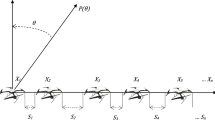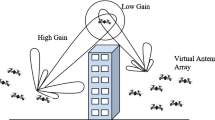Abstract
This research presents a design approach of a dual-band virtual antenna array for future flying ad-hoc networks. The design approach consists in applying non-uniform positions and the time modulation technique as element excitations. The main problem is to generate the positions and time sequences that permit low side lobes, as well as low harmonics in the radiation pattern of 2.4 GHz and 5.5 GHz. This problem is solved by utilizing the algorithm of differential evolution for multiobjective optimization. It is presented a virtual array with eight microstrip fed-slot antennas mounted on real drone bodies. The results are analyzed with a comparison among the patterns generated of a uniform array, the patterns generated of a non-uniform array and the pattern generated of a non-uniform array with perturbations in the element positions. The results show the good performance of the array even if the element positions are perturbed due to the sudden flight movements. It was achieved a side lobe level reduction of 7.36 dBi for 2.4 GHz and 5.8 dBi for 5.5 GHz with respect to the maximum directivity of the main lobe. And a harmonic level reduction of 7.7 dBi for both frequencies with respect to the maximum directivity of the main lobe.







Similar content being viewed by others
References
Bürkle, A., Segor, F., & Kollmann, M. (2011). Towards autonomous micro UAV swarms. Journal of Intelligent and Robotic Systems, 61(1–4), 339–353.
Sivakumar, A., & Tan, C. K. Y. (2010). UAV swarm coordination using cooperative control for establishing a wireless communications backbone. In Proceedings of the 9th international conference on autonomous agents and multiagent systems (Vol. 3, pp. 1157–1164).
Clare, L. P., Gao, J. L., Jennings, E. H., & Okino, C. (2005). A network architecture for precision formation flying using the IEEE 802.11 MAC protocol. In 2005 IEEE aerospace conference (pp. 1335–1347). IEEE.
Dohler, M., & Aghvami, A. H. (2006). Distributed antennas: The concept of virtual antenna arrays. In: Cooperation in wireless networks: Principles and applications (pp. 421–461). Dordrecht: Springer.
Dohler, M., Lefranc, E., & Aghvami, H. (2002). Space-time block codes for virtual antenna arrays. In The 13th IEEE international symposium on personal, indoor and mobile radio communications (Vol. 1, pp. 414–417). IEEE.
Mghabghab, S., Schlegel, A., Gress, R., & Nanzer, J. A. (2020). Long-range wireless frequency synchronization for distributed phased arrays. In 2020 IEEE international symposium on antennas and propagation and North American Radio Science Meeting (pp. 1253–1254). IEEE.
Chatterjee, P., Nanzer, J. A., & Yan, M. (2020). Frequency consensus for distributed antenna arrays with half-duplex wireless coordination. In 2020 IEEE international symposium on antennas and propagation and North American Radio Science Meeting (pp. 1585–1586). IEEE.
Keskin, F., & Filik, T. (2020). Isotropic and directional DOA estimation of the target by UAV swarm-based 3-D antenna array. In 2020 4th international symposium on multidisciplinary studies and innovative technologies (ISMSIT) (pp. 1–7). IEEE.
Garza, J., Panduro, M. A., Reyna, A., Romero, G., & Rio, C. D. (2016). Design of UAVs-based 3D antenna arrays for a maximum performance in terms of directivity and SLL. International Journal of Antennas and Propagation. https://doi.org/10.1155/2016/2621862
Wang, W., Zheng, Z., Chen, M., Zhang, H., & Liang, X. (2020). An unmanned aerial vehicle antenna array. In 2020 IEEE international symposium on antennas and propagation and North American Radio Science Meeting (pp. 183–184). IEEE.
Reyna, A., Garza, J. C., Elizarraras, O., Panduro, M., Balderas, L. I., & de la Luz Prado, M. (2021). 3D random virtual antenna arrays for FANETs wireless links. Telecommunication Systems, 77(3), 469–477.
Mozaffari, M., Saad, W., Bennis, M., & Debbah, M. (2018). Drone-based antenna array for service time minimization in wireless networks. In 2018 IEEE international conference on communications (ICC) (pp. 1–6). IEEE.
Sun, G., et al. (2020). Improving performance of distributed collaborative beamforming in mobile wireless sensor networks: A multi-objective optimization method. IEEE Internet of Things Journal, 7, 6787–6801.
Dohler, M., Dominguez, J., & Aghvami, H. (2002). Link capacity analysis for virtual antenna arrays. In Proceedings IEEE 56th vehicular technology conference, Vancouver, BC, Canada (Vol. 1, pp. 440–443). IEEE.
Wang, W.-Q. (2012). Virtual antenna array analysis for MIMO synthetic aperture radars. International Journal of Antennas and Propagation, 2012(587276), 10.
Jan, S. S., & Enge, P. (2000). Using GPS to synthesize a large antenna aperture when the elements are mobile. In Proceedings of the 2000 national technical meeting of the institute of navigation, Anaheim, CA (pp. 1–11).
Milyakov, D. A., Verba, V. S., Merkulov, V. I., & Plyashechnik, A. S. (2021). Quadcopter active phased antenna array. Procedia Computer Science, 186, 628–635.
Breheny, S. H., D’Andrea, R., & Miller, J. C. (2003). Using airborne vehicle-based antenna arrays to improve communications with UAV clusters. In 42nd IEEE international conference on decision and control (Vol. 4, pp. 4158–4162). IEEE.
Chandra, R. S., Breheny, S. H., & D’Andrea, R. (2008). Antenna array synthesis with clusters of unmanned aerial vehicles. Automatica, 44(8), 1976–1984.
Bulusu, N., Aryafar, E., & Liu, F. (2021). Towards adaptive, self-configuring networked unmanned aerial vehicles. In Proceedings of the 7th workshop on micro aerial vehicle networks, systems, and applications (pp. 25–30).
Gai, S., Jiao, Y.-C., Yang, Y.-B., Li, C.-Y., & Gong, J.-G. (2010). ‘Design of a novel microstrip-fed dual-bandslot antenna for WLAN applications.’ Progress in Electromagnetics Research Letters, 13(1), 75–81.
Jiménez, D. A., Reyna, A., Panduro, M. A., et al. (2020). UAVs-based antenna arrays using time modulation. Telecommunication Systems, 74, 113–127. https://doi.org/10.1007/s11235-019-00640-1
Reyna, A., Panduro, M. A., Mendez, A., Balderas, L., & Del- Río, C. (2019). Distributed antenna array for FANET’s wireless links using time modulation. In 2019 13th European conference on antennas and propagation (EuCAP) (pp. 1–3). IEEE.
Kummer, W., Villeneuve, A., Fong, T., & Terrio, F. (1963). Ultra-low sidelobes from time-modulated arrays. IEEE Transactions on Antennas and Propagation, 11(6), 633–639.
Robic, T., & Bogdan, F. (2005). DEMO: Differential evolution for multiobjective optimization. Lecture Notes in Computer Science, EMO, 3410, 520–533.
Commercial Software available at https://www.cst.com
Panduro, M. A., Brizuela, C. A., Garza, J., Hinojosa, S., & Reyna, A. (2013). A comparison of NSGA-II, DEMO, and EM-MOPSO for the multi-objective design of concentric rings antenna arrays. Journal of Electromagnetic Waves and Applications, 27(9), 1100–1113.
Funding
The authors have not disclosed any funding.
Author information
Authors and Affiliations
Corresponding author
Ethics declarations
Conflict of interest
The authors declare that they have no conflict of interest.
Additional information
Publisher's Note
Springer Nature remains neutral with regard to jurisdictional claims in published maps and institutional affiliations.
Rights and permissions
Springer Nature or its licensor holds exclusive rights to this article under a publishing agreement with the author(s) or other rightsholder(s); author self-archiving of the accepted manuscript version of this article is solely governed by the terms of such publishing agreement and applicable law.
About this article
Cite this article
Garza, J.C., Reyna, A., Balderas, L.I. et al. Dual-band virtual antenna array with time modulation in presence of position perturbations. Telecommun Syst 81, 539–547 (2022). https://doi.org/10.1007/s11235-022-00960-9
Accepted:
Published:
Issue Date:
DOI: https://doi.org/10.1007/s11235-022-00960-9




